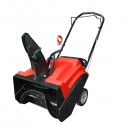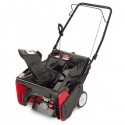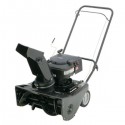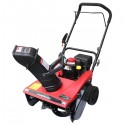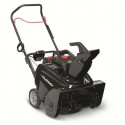Gas Single-Stage Snow Blower Reviews
These are the 10 best gas single-stage snow blowers based on product quality, customer satisfaction, and price:
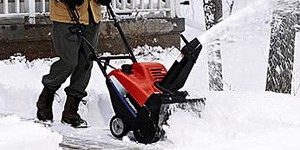 A gas single stage snow blower is a snow clearing machine with a combustion engine and a single part snow clearing system in which the machine’s auger – the part that scoops snow off the ground and pushes it up through the snow chute – does all of the work. The auger on a single stage snow blower also makes contact with the surface of the ground as it scoops up snow, which makes it ideal for use on paved surfaces but unsafe and inefficient to use on unpaved or gravel drives. This is because on unpaved surfaces, there is a risk that the auger will scoop up gravel or other debris along with the snow and fling it through the snow chute, potentially damaging property and presenting safety concerns.
A gas single stage snow blower is a snow clearing machine with a combustion engine and a single part snow clearing system in which the machine’s auger – the part that scoops snow off the ground and pushes it up through the snow chute – does all of the work. The auger on a single stage snow blower also makes contact with the surface of the ground as it scoops up snow, which makes it ideal for use on paved surfaces but unsafe and inefficient to use on unpaved or gravel drives. This is because on unpaved surfaces, there is a risk that the auger will scoop up gravel or other debris along with the snow and fling it through the snow chute, potentially damaging property and presenting safety concerns.
Gas single stage snow blowers are ideal for homeowners who have medium sized driveways and fairly long sidewalks to keep clear, particularly because they are designed to clear snow all the way down to the surface of the ground. They have the kind of big clearance widths that allow you to finish these kinds of jobs quickly and efficiently. And they have the kind of higher snow cut depths that allow you to reliably use them under heavy snow fall conditions in just about any region of the United States, even those like the Northeast or Great Plains that are prone to experiencing severe snow storms several times during the winter. At the same time, they are designed for and operate best on suburban style properties that experience frequent snow fall of about 8 to 12 inches at a time.
Gas single stage snow blowers have the kind of robust, powerful engines that have high snow clearance capacities per minute and can throw snow relatively far distances, especially when compared to smaller, electric single stage snow blowers. The combustion engines on gas single stage snow blowers provide enough power to move upwards of 1000 pounds of snow per minute and clear paths of 26 inches or more. The engines on gas single stage snow blowers can be 2-cycle or 4-cycle and have either electric or recoil starts. They are typically designed to start reliably in cold weather, and a number of models are available that use less fuel and produce limited emissions.
If you have a wider than average, paved driveway and you live in a region that gets heavy snowfall on a regular basis through the winter months, a gas single stage snow blower can offer exactly what you need for reliable, efficient snow clearing jobs. These machines have the kind of power, size, and robust engines you can count on to take care of these jobs repeatedly over the long term. They have extra wide clearances that can clear a typical sidewalk in just two passes or else cut a sufficiently wide walkway in just a single pass. They can handle serious snow storms with ease, and they will dig out a two car driveway in a matter of minutes.
1. Gas Single-Stage Snow Blower Selection Criterias
1a. Engine
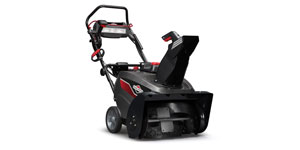 The combustion engine on a gas single-stage snow blower is going to be a very important criterion that will determine the extent to which a number of other critical aspects of the machine are able to perform. Factors like the engine size, torque, and horsepower will determine the size and power of the snow blower’s auger and the machine’s snow clearance capacity. Other aspects of the engine’s design, such as whether it is a 2-cycle or 4-cycle engine and if it has an overhead valve design, will determine the amount and difficulty level of the maintenance it will require. Finally, the degree to which the engine is designed to be fuel efficient will determine not only how much you will have to spend on gas every winter but also how much emissions the snow blower will produce.
The combustion engine on a gas single-stage snow blower is going to be a very important criterion that will determine the extent to which a number of other critical aspects of the machine are able to perform. Factors like the engine size, torque, and horsepower will determine the size and power of the snow blower’s auger and the machine’s snow clearance capacity. Other aspects of the engine’s design, such as whether it is a 2-cycle or 4-cycle engine and if it has an overhead valve design, will determine the amount and difficulty level of the maintenance it will require. Finally, the degree to which the engine is designed to be fuel efficient will determine not only how much you will have to spend on gas every winter but also how much emissions the snow blower will produce.
The displacement of an engine, measured in cubic centimeters, along with its torque and horsepower, determine how much power it can produce. Displacement is the quickest measure of an engine’s potential power; to put it simply, bigger engines are more powerful. But this is only true most of the time. A number of manufacturers have been designing compact engines that produce more power than bigger ones made by their competitors. As a result, it is important to take torque and horsepower into account as well.
Torque measures the rotational power of the engine and determines how much power is being transferred through the machine’s drive shaft to the auger and propulsion system, if there is one. Horsepower, which is probably the most familiar term to most readers, is a general unit of measurement for the engine’s total power. Single stage snow blowers will typically have horsepower that measures around 6 or 7 up to a dozen HP or more.
2-cycle engines need a mixture of gas and oil to run but do not need you to periodically change the oil, whereas in 4-cycle engines the oil is stored in a separate crankcase and will need to be changed once or twice a year. This makes 4-cycle engines more work to maintain but also allows them to be more powerful and have better fuel economy and fewer emissions. An engine with an overhead valve design (OHV) will be more compact and lightweight, but will also be noisier and be more difficult to maintain. Finally, an engine that is more fuel efficient and produces fewer emissions will reduce your carbon footprint and require you to spend less on gas, but may have limitations in terms of power.
1b. Auger
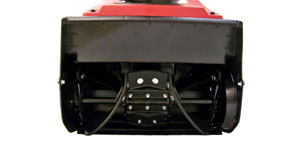 There are a number of important features of the auger that will affect the snow blower’s ability and performance. The auger is the primary mechanical piece of the snow blower: it is the “teeth” of the machine, and it is the component that scoops snow up off the ground and throws it out the snow chute. Unlike a two stage snow blower, which has a secondary component, called the impeller fan, that helps pull snow up away from the auger and throw it through the snow chute, on a single stage snow blower the auger alone does all of the work. As a result, it is important to purchase a snow blower with an auger that is robust, powerful, and will be reliable over the long term.
There are a number of important features of the auger that will affect the snow blower’s ability and performance. The auger is the primary mechanical piece of the snow blower: it is the “teeth” of the machine, and it is the component that scoops snow up off the ground and throws it out the snow chute. Unlike a two stage snow blower, which has a secondary component, called the impeller fan, that helps pull snow up away from the auger and throw it through the snow chute, on a single stage snow blower the auger alone does all of the work. As a result, it is important to purchase a snow blower with an auger that is robust, powerful, and will be reliable over the long term.
In addition to not having an impeller fan, the next area in which single stage snow blowers differ significantly from two stage snow blowers is that the auger on a single stage snow blower makes contact with the surface of the ground as it passes over it. This has advantages as well as disadvantages. The advantages include the fact that there will be no layer of snow left behind after the single stage snow blower has passed over an area of the driveway. In addition there is the fact that on many smaller models, the auger itself is able to two jobs: clearing snow as well as pulling the snow blower forward. Two stage snow blowers cannot do this, and require secondary drive systems.
But because the auger is making contact with the ground as it moves over it, it cannot be used on unpaved areas. In addition, the auger on a single stage snow blower is going to be subjected to much more wear and tear due to the fact that it is scraping over concrete or asphalt as it works. Therefore it is important to make sure you are purchasing a snow blower with an auger made of sufficiently durable materials.
The best possible design for an auger will be hardened steel with rubber tips. The steel will hold up to tough jobs and the rubber tips will protect the surface of the driveway from scrapes or scratches. The least durable augers are typically made from plastic, and they are not going to be able to hold up to tough jobs over the long term, although they will be sufficient for clearing decks or other easy jobs. Be sure you are getting a single stage snow blower that has the right kind of auger for your needs.
1c. Snow Cut Depth
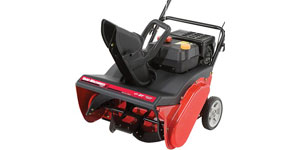 Snow cut depth and clearance width are two specs that will have a huge impact on the degree of efficiency you will be able to clear your driveway and other areas with as well as how much snow fall your single stage snow blower will be able to handle. Snow cut depth measures how much snow fall a particular snow blower will be able to reliably clear. Generally speaking, gas powered single stage snow blowers should be able to handle at least eight to ten inches, but there are heavy duty models available that can clear heavy snow fall that is as deep as twelve or even sixteen inches.
Snow cut depth and clearance width are two specs that will have a huge impact on the degree of efficiency you will be able to clear your driveway and other areas with as well as how much snow fall your single stage snow blower will be able to handle. Snow cut depth measures how much snow fall a particular snow blower will be able to reliably clear. Generally speaking, gas powered single stage snow blowers should be able to handle at least eight to ten inches, but there are heavy duty models available that can clear heavy snow fall that is as deep as twelve or even sixteen inches.
It is important to find a balance between the maximum capacity of snow fall your single stage snow blower will be able to handle and the overall size and weight of the machine. While it can certainly be useful to have a single stage snow blower with an extra high snow cut depth when a big snow storm rolls through, if you do not live in a region where these kinds of weather events are common, you may not need a machine with a sixteen inch snow cut depth.
Of course, if you live in a region that gets a few deep snow storms every winter, the extra inches will come in handy. But if you do not, you may be wasting money on a big machine that you don’t necessarily need. It can be very useful to determine the average depth of snow storms in your area and base your snow cut depth parameters on that figure.
Clearance width is as important as snow cut depth in terms of the efficiency of the single stage snow blower you purchase. Clearance width measures how broad a path the snow blower is able to cut through the snow. A wider clearance means you will be able to finish a job in fewer passes, and fewer passes means less time spent on a given area. Less time is always better, but as with the snow cut depth, you want to base your decision on a balance that helps you clear your driveway quickly but is not so big as to be unwieldy. A larger clearance width may be inefficient if you only have a single car driveway, or a short, narrow walkway to keep clear, and a big machine will only use more gas and take up more space in your garage.
1d. Drive System
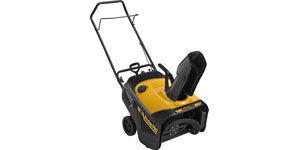 Unlike two stage snow blowers, which only have one option for the drive system – a rear wheel drive that operates separately from the auger – single stage snow blowers have two options. They can have a rear wheel drive system similar to those on two stage snow blowers, or they can rely on the auger to pull the snow blower forward, since it makes contact with the ground. There are advantages and drawbacks to each system.
Unlike two stage snow blowers, which only have one option for the drive system – a rear wheel drive that operates separately from the auger – single stage snow blowers have two options. They can have a rear wheel drive system similar to those on two stage snow blowers, or they can rely on the auger to pull the snow blower forward, since it makes contact with the ground. There are advantages and drawbacks to each system.
Having the auger do all of the work of pulling the snow blower along has the advantage that you will have a more compact machine and not need extra power from the engine being directed to the rear wheel drive, along with the fact that single stage snow blowers with auger drives are typically less expensive than those with rear wheel drives. On the other hand, single stage snow blowers that rely on augers to drive them usually cannot go as fast and do not have as many speed options as those with separate propulsion systems, and they typically can’t go backwards as easily, since they often do not have any reverse option.
Single stage snow blowers with an additional drive system have the advantage that they will have multiple speeds, so you can pick the one that is right for you, and they can often drive themselves in reverse, which makes them easier to maneuver in tight spaces. They are also better equipped to negotiate sloping ground than the frontal auger drive system can. Their major drawback is that they make for a bigger overall footprint on the snow blower, and also require bigger, more powerful engines that use more gas and produce higher emissions.
As a result, single stage snow blowers that use the auger as a propulsion system are ideal for use on smaller, less complicated jobs. If you are just clearing a single or two car driveway, or if you are clearing a large deck or a short sidewalk, relying on the auger to drive the snow blower should be sufficient. But if you are responsible for keeping a larger area clear, or if you are clearing a driveway on a sloping hill or one that is uneven and requires better maneuvering and traction, a single stage snow blower with an additional drive system will probably be the better option.
1e. Accessories
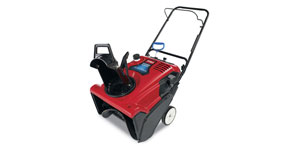 The final considerations on a gas single stage snow blower to look at, after you have pared down your list based on the more important questions discussed above, deal with the additional options that can dramatically improve the snow clearing experience. They concern available accessories and the overall design of the machine.
The final considerations on a gas single stage snow blower to look at, after you have pared down your list based on the more important questions discussed above, deal with the additional options that can dramatically improve the snow clearing experience. They concern available accessories and the overall design of the machine.
Some single stage snow blowers are equipped with convenient add-ons such as powerful LED or halogen headlights. These are extremely useful, and get more so the further north you live, where winter days are shorter than ever. In these regions, you never know when you might have to be clearing snow early in the morning or after the sun has already gone down, and under those circumstances it is important to be able to see where you’re going. This will affect not only how clean you get the driveway but also your safety level while you are doing the job.
The snow chute material and design is likewise an important, if seemingly minor, consideration. It’s important to make sure that the snow chute has a sufficient turning radius to allow you to clear snow to one side or the other. A 180 degree turning radius is ideal, because this will allow you to clear a wide driveway in back and forth passes while directing all of the snow to one side or the other easily. You also want to make sure the snow chute is manufactured out of sufficiently durable material to be able to stand up to wear and tear over the long term. If the snow chute breaks, it will render the snow blower all but useless.
Additionally, the overall design of the machine is important. One of the main reasons we prefer to use snow blowers over manual snow shovels is because clearing even a short walkway with a snow shovel can leave your back aching and your shoulders sore. Therefore it is important to make sure you are getting a single stage snow blower that has a sufficiently adjustable handle that you will not have to hunch over it to operate it. It’s even better if the handle is padded to protect your hands and wrists from the vibration of the machine. An overall design that is ergonomic will do a lot to help keep you from straining your back or arms while clearing your driveway, and it will go a long way to making your snow clearing experience much better.
2. Best Gas Single-Stage Snow Blower Reviews
Toro Power Clear 418 




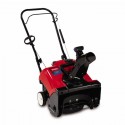
The Toro Power Clear 418 is a compact and lightweight snow blower that is specifically designed to help homeowners who live in regions that do not get exceptionally heavy snow fall during winter storms. It’s made to take care of the average one car driveway quickly and efficiently, and that is exactly what it does. [...]
Toro Power Clear 621R 




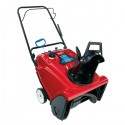
The Toro Power Clear 621R is the perfect single stage snow blower for use on paved driveways and sidewalks, and it is able to handle moderate snow fall at an impressive rate. The Toro Power Clear 621R can clear up to nine hundred pounds of snow per minute under the right conditions, which means that [...]
Poulan Pro PR621ES 




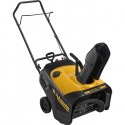
The Poulan Pro PR621ES is the kind of tough little snow blower that is going to be able to stand up to a range of serious conditions without ever losing anything in terms of power or performance. With one of the biggest engines you can find on a single stage snow blower, it has all [...]
Snapper 1695880 SS822E 





The Snapper 1695880 SS822E is the kind of single-stage snow blower that will be able to make short work of big jobs. It does not matter how wider your driveway is, with the Snapper 1695880 SS822E in your garage, you will be able to clear snow from it in less time than you could with [...]
Toro Power Clear 621QZE 




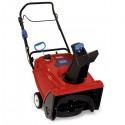
The Toro Power Clear 621QZE is a very well designed snow blower that manages to pack everything you need to keep your driveway clear of snow in a surprisingly small package. This machine has all of the power you need to clear large amounts of heavy snow quickly and efficiently, and it is designed to [...]
These are the 10 best gas single-stage snow blowers based on product quality, customer satisfaction, and price:

